Nsg 321 infection - Study guides, Class notes & Summaries
Looking for the best study guides, study notes and summaries about Nsg 321 infection? On this page you'll find 32 study documents about Nsg 321 infection.
Page 3 out of 32 results
Sort by
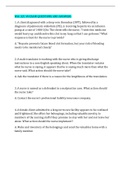
-
NSG 321 V4 EXAM QUESTIONS AND ANSWERS
- Exam (elaborations) • 21 pages • 2022
-
- $14.49
- + learn more
NSG 321 V4 EXAM QUESTIONS AND ANSWERS 1. A client diagnosed with a deep vein thrombus (DVT), followed by a diagnosis of pulmonary embolism (PE), is receiving heparin via an infusion pump at a rate of 1400 U/hr. The client tells the nurse, “I wish this medicine would hurry up and dissolve this clot in my lung so that I can go home.” What response is best for the nurse to provide? A. “Heparin prevents future blood clot formation, but your risk of bleeding needs to be monitored cl...
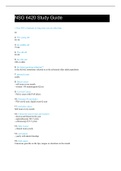
-
NSG 6420 Final Exam Study Guide (450 Question and Answers)
- Exam (elaborations) • 54 pages • 2022
-
Available in package deal
-
- $44.99
- + learn more
NSG 6420 Final Exam Study Guide 1.Over 90% of patients in long term care are older than 2. The young old 3. the middle old 4. The old old 5. the elite old 6. the fastest growing subgroup?? 7. physical exam 8. Breast cancer 9. Cervical Cancer 10. Prostate (50 and older) 11. testicular cancer 12. Colorectal cancer (men and women) 13. Skin Cancer 14. oral cancer 15. Oral cancer 16. Bone density 17. Vision 18. Immunnizations 19. Genetic T...
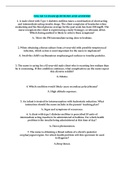
-
NSG 321 V2 EXAM QUESTIONS AND ANSWERS
- Exam (elaborations) • 23 pages • 2022
-
- $15.00
- + learn more
NSG 321 V2 EXAM QUESTIONS AND ANSWERSA male client with Type 1 diabetes mellitus takes a combination of short-acting and intermediate-acting insulin drugs. The client complains of headaches when awakening and his blood glucose average for the past week has been 210 mg/dl. The nurse recognizes the client is experiencing a daily Somogyi, or rebound, effect. Which dosing method is likely to relieve these symptoms? A. Move the PM intermediate-acting dose to bedtime. 2. When obtaining a thr...
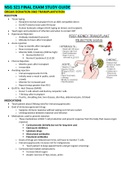
-
NSG 321 FINAL EXAM STUDY GUIDE
- Exam (elaborations) • 15 pages • 2022
-
- $14.49
- + learn more
NSG 321 FINAL EXAM STUDY GUIDE ORGAN DONATION AND TRANSPLANTATION REJECTION • Tissue typing o Recipient receives transplant from an ABO compatible doron o Do NOT need to have same Rh factor o Human leukocyte antigen (HLA) typing on donors and recipients • Teach signs and symptoms of infection and when to contact HCP • Hyperacute Rejection o Antibody mediated (humoral) o Minutes to hours after transplant • Acute rejection o Days to months after transplant o New incisional pai...
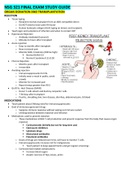
-
NSG 321 FINAL EXAM STUDY GUIDE
- Exam (elaborations) • 15 pages • 2022
-
- $14.49
- + learn more
NSG 321 FINAL EXAM STUDY GUIDE ORGAN DONATION AND TRANSPLANTATION REJECTION • Tissue typing o Recipient receives transplant from an ABO compatible doron o Do NOT need to have same Rh factor o Human leukocyte antigen (HLA) typing on donors and recipients • Teach signs and symptoms of infection and when to contact HCP • Hyperacute Rejection o Antibody mediated (humoral) o Minutes to hours after transplant • Acute rejection o Days to months after transplant o New incisional pai...
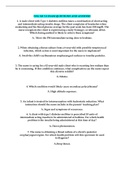
-
NSG 321 V2 EXAM QUESTIONS AND ANSWERS
- Exam (elaborations) • 23 pages • 2021
-
- $15.00
- + learn more
NSG 321 V2 EXAM QUESTIONS AND ANSWERSA male client with Type 1 diabetes mellitus takes a combination of short-acting and intermediate-acting insulin drugs. The client complains of headaches when awakening and his blood glucose average for the past week has been 210 mg/dl. The nurse recognizes the client is experiencing a daily Somogyi, or rebound, effect. Which dosing method is likely to relieve these symptoms? A. Move the PM intermediate-acting dose to bedtime. 2. When obtaining a thr...
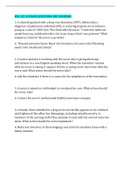
-
NSG 321 V4 EXAM QUESTIONS AND ANSWERS
- Exam (elaborations) • 21 pages • 2022
-
- $14.00
- + learn more
NSG 321 V4 EXAM QUESTIONS AND ANSWERSA client diagnosed with a deep vein thrombus (DVT), followed by a diagnosis of pulmonary embolism (PE), is receiving heparin via an infusion pump at a rate of 1400 U/hr. The client tells the nurse, “I wish this medicine would hurry up and dissolve this clot in my lung so that I can go home.” What response is best for the nurse to provide? A. “Heparin prevents future blood clot formation, but your risk of bleeding needs to be monitored closely...
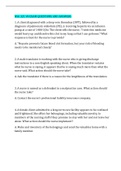
-
NSG 321 V4 EXAM QUESTIONS AND ANSWERS
- Exam (elaborations) • 21 pages • 2022
-
- $14.49
- + learn more
NSG 321 V4 EXAM QUESTIONS AND ANSWERS 1. A client diagnosed with a deep vein thrombus (DVT), followed by a diagnosis of pulmonary embolism (PE), is receiving heparin via an infusion pump at a rate of 1400 U/hr. The client tells the nurse, “I wish this medicine would hurry up and dissolve this clot in my lung so that I can go home.” What response is best for the nurse to provide? A. “Heparin prevents future blood clot formation, but your risk of bleeding needs to be monitored cl...
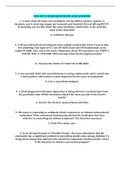
-
NSG 321 V3 EXAM QUESTIONS AND ANSWERS
- Exam (elaborations) • 21 pages • 2022
-
- $14.49
- + learn more
NSG 321 V3 EXAM QUESTIONS AND ANSWERS 1. A male client develops oral candidiasis. He has MRSA-positive sputum, is dyspneic, and is receiving oxygen per facemask and linezolid (Zyvox) 600 mg BID IV. In planning care for this client, the nurse identifies which factor as the probable cause of the stomatitis? A. Antibiotic therapy. 2. A 38-year-old male client collapsed at his outside construction job in Texas in July. His admitting vital signs to ICU are: BP 82/70, heart rate 140 beats/m...

-
NSG 321 V3 EXAM QUESTIONS AND ANSWERS
- Exam (elaborations) • 21 pages • 2022
-
- $14.49
- + learn more
NSG 321 V3 EXAM QUESTIONS AND ANSWERS 1. A male client develops oral candidiasis. He has MRSA-positive sputum, is dyspneic, and is receiving oxygen per facemask and linezolid (Zyvox) 600 mg BID IV. In planning care for this client, the nurse identifies which factor as the probable cause of the stomatitis? A. Antibiotic therapy. 2. A 38-year-old male client collapsed at his outside construction job in Texas in July. His admitting vital signs to ICU are: BP 82/70, heart rate 140 beats/m...

How much did you already spend on Stuvia? Imagine there are plenty more of you out there paying for study notes, but this time YOU are the seller. Ka-ching! Discover all about earning on Stuvia


